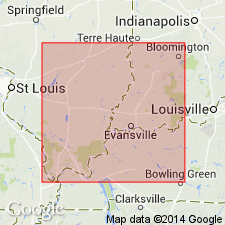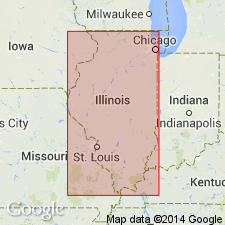
- Usage in publication:
-
- Absher limestone
- Modifications:
-
- Original reference
- Dominant lithology:
-
- Limestone
- AAPG geologic province:
-
- Illinois basin
Summary:
Pg. 17 (fig. 3), 23. Absher limestone of Carbondale group. Comparatively thin and somewhat impure bed. Overlies Harrisburg (No. 5) coal; in vicinity of Harrisburg, generally separated from coal by as much as 20 feet of shale (bed 6 of complete cyclothem). Included in St. David cyclothem. [Age is Middle Pennsylvanian (Des Moines).]
Named from village in southeastern Williamson Co., southern IL.
Source: US geologic names lexicon (USGS Bull. 1200, p. 14).

- Usage in publication:
-
- Absher Limestone†
- Modifications:
-
- Abandoned
- AAPG geologic province:
-
- Illinois basin
Summary:
Pg. 54 (table 3). †Absher Limestone of Carbondale Group. Replaced with St. David limestone member of Carbondale formation. Report presents new rock-stratigraphic classification of Pennsylvanian strata in Illinois. Cyclical classification is retained but is entirely independent of rock-stratigraphic classification.
Source: US geologic names lexicon (USGS Bull. 1200, p. 14).
For more information, please contact Nancy Stamm, Geologic Names Committee Secretary.
Asterisk (*) indicates published by U.S. Geological Survey authors.
"No current usage" (†) implies that a name has been abandoned or has fallen into disuse. Former usage and, if known, replacement name given in parentheses ( ).
Slash (/) indicates name conflicts with nomenclatural guidelines (CSN, 1933; ACSN, 1961, 1970; NACSN, 1983, 2005, 2021). May be explained within brackets ([ ]).

